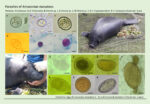Parasites of Amazonian manatees in a rescue center in Loreto, Peru
Jim W. Ruiz P., Malika Gottstein, Juan J. E. Sánchez B., Mirle Cachique P., Franco I. Macedo T., Carmen T. ReateguiThe Amazonian manatee, Trichechus inunguis, is the only sirenian present in freshwater rivers and is classiffied as a “vulnerable” species according to the IUCN. Individuals rescued from the pet trade in Peruvian Amazonia are brought to the Centro de Rescate Amazónico (CREA), rehabilitated, and released to their natural environment. Parasitic diseases can cause serious problems in the rehabilitation and release of rescued animals. In this study, entero- and hemoparasites of ten manatees in the rehabilitation facilities of the CREA in Loreto, Peru were studied. Parasites were searched in fecal and blood samples using the Willis method, Kinyoun stain, and Giemsa stain. Six species of protozoan parasites from the genera Eimeria, cf. Cyclospora, cf. Cryptosporidium and cf. Entamoeba were observed. Helminths (six species of nematodes and one trematode) were recorded. Hemoparasites were not detected. Our results give insights into the presence of parasites in captive Amazonian manatees and should be taken into account in future rehabilitation and reintroduction processes.
Parásitos del manatí amazónico en un centro de rescate en Loreto, Perú. El manatí amazónico, Trichechus inunguis, es el único sirenio presente en agua dulce y está clasificado como especie «vulnerable» según la UICN. Los manatíes rescatados del tráfico ilegal en la Amazonia peruana son llevados al Centro de Rescate Amazónico (CREA), donde se rehabilitan y reintroducen a su medio natural. Las enfermedades parasitarias causan serios problemas en la rehabilitación y liberación de los animales rescatados. Se estudiaron enteroparásitos y hemoparásitos de diez manatíes en las instalaciones de rehabilitación del CREA en Loreto, Perú. Se buscaron parásitos desde muestras fecales y de sangre mediante el método de Willis, la tinción de Kinyoun y la tinción de Giemsa. Se detectaron seis especies de parásitos protozoos de los géneros Eimeria, cf. Cyclospora, cf. Cryptosporidium y cf. Entamoeba. Se registraron helmintos (seis especies de nematodos y un trematodo). No se hallaron hemoparásitos. Nuestros resultados aportan información sobre la presencia de parásitos en los manatíes amazónicos en cautiverio y deberían tenerse en cuenta en futuros procesos de rehabilitación y reintroducción.

